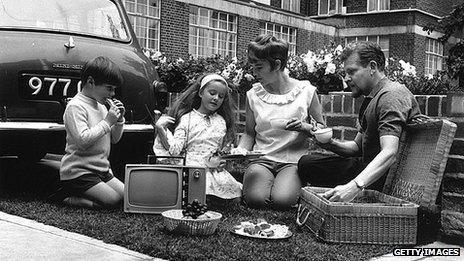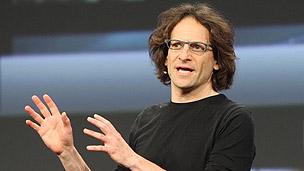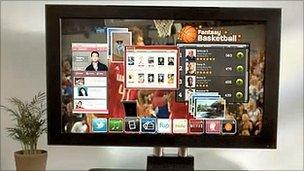Beyond the couch: TV goes social, goes everywhere
- Published

TV on the go? Making your television viewing a social, mobile experience wasn't quite as easy before tablets and smartphones
Sitting on the train on a rainy Monday night, after a long day at work, you have a look on your smartphone to see what's on television.
Your TV operator's app thinks you might enjoy The Big Lebowski. After all your best mate has "liked" it on Facebook. And it's on TV right now.
A big fan of the Dude you whip out your iPad and start watching, swapping favourite quotes with your mate who you have invited to watch it with you through a chat window on your smartphone.
All too soon you reach your stop. You pause it, and head home. Once there you flop on the sofa and switch on the TV, where the film is waiting for you to pick up where you left off.
According to the industry experts attending IBC, the annual broadcasting industry gathering in Amsterdam, this could be the future of television.
And you, the viewer, is driving it.
Status update
According to Facebook's Joanna Shields, the social network's 750m users are sharing twice as much as they did a year ago about their likes and dislikes. So integrating social media and television, harnessing this data to encourage consumers to watch more television seems obvious.

The world's broadcast industry gather in Amsterdam every year
"Facebook represents the biggest opportunity the television industry has ever faced - the potential to tap into a global audience that is waiting to discover, share and amplify your stories," she says.
"For media companies and marketers, it's the power of social discovery and the authentic conversations it enables that's the key to unlocking a whole new way to produce, promote and advertise on television."
"Social TV represents a period of renaissance for the TV industry to define new ways of engaging audiences and telling great stories."
Looking around Amsterdam's RAI conference centre, it seems a lot of people agree with her.
Virtual togetherness
TV services technology company SeaChange certainly does.
Their Nitro software gives TV operators and broadcasters the means to create a multiscreen user interface for their content. The Affinity application adds social media integration.
It also tries to recreate the feeling of television viewing as a group activity with the ability to start a "virtual party". This lets you watch with distant friends, and chat about it via video, voice or text.

SeaChange's Nitro software lets service providers offer content on different devices such as the iPad
SeaChange's Paul de Bot says it is in the interests of operators to embrace social television.
"You can have a recommendation engine, recommending content to users. We know that's effective.
"What's also effective is friends or someone in your social group who is recommending something.
"Social recommendations trigger much higher views than traditional context recommendations. That can really help operators to increase viewing which may help to increase the revenue stream."
Competing interests
This is not an all or nothing situation, according to Anthony Rose, ex-CTO of YouView.
His new venture, start-up Zeebox, is due to launch an app aimed at making television a more social experience. Using a "companion" device such as a tablet or laptop, you can see what friends are watching, and watch it with them.
"Essentially the audience is split. People older than 35 are not as keen on social. People younger than 35 can't live without social," he says.
"Any proposition that is purely social will get one audience demographic but lose out on the older demographic, and for that reason we tried to combine a number of things that are not all about social, in fact you can choose to not log in with Facebook."

Zeebox's Anthony Rose says forced social media integration could alienate some of the audience
The app scans live television and generates clickable tags that give more information on what you are watching.
"Our user research said people love more information around what they're watching on TV. They love to buy things they see on TV. They love to get more episodes of what they see on TV."
Where social really helps, says Mr Rose, is in programme choice.
"Giving people a directory of a thousand things is going to be an unhappy experience. Guiding people to something they want to watch is desirable. I think social is going to play a major part in that."
Making it pay
IBM's John Konczal agrees. The company's Smarter Commerce for Media package helps content owners to sell their product. It uses analytics, marketing tools and social media integration.
"Social media integration is absolutely essential. You're much more likely to buy on recommendation from your friend, your sister.
"It's the sharing of information across Facebook and Twitter. There's no separation - any selling experience, any marketing experience must take advantage of social media."
But what about social networks that do not allow users to "like" things, Twitter for instance?

Cisco's Videoscape platform hosts content in the cloud which is then delivered to different devices
Cisco's Videoscape platform aggregates content from TV, online, and on-demand sources. The cloud-based system can be used on different devices and customised to suit the individual operator.
As well as using "likes", the system will scan your Twitter feed and give recommendations based on what people you follow are talking about.
Ken Morse is chief technology officer for Cisco's video technology group. He says multiple devices bring their own problems.
"Before it was a content or service provider push towards consumers, and now it's turning very much into a pull.
"Content is still king, the consumer is rising, and it's about the consumer wanting their content whenever, wherever, over whatever network at anytime.
"We talk about delivering to these devices, well most of the content rights that service providers have allow delivery within the home. But the moment I walk out the front door what happens?"
Perpetual motion
Serving different devices can mean adopting web technologies.
Pace are best known for set-top boxes, but have branched out in recent years.
Their new Elements software platform is designed to allow pay-TV operators to design their own customer experience, that can be pushed to multiple devices. It is open source, based on Java script and HTML5.

Pace's Elements platform lets operators design and build their own applications
Chief technology officer Paul Entwhistle says innovation is the driving factor.
"By using the same technologies that drive innovation on the web it frees service providers to move at their own pace and under their own control.
"The industry needs to have tools that allows it to drive the user experience on other devices."
Jeff Rosica of Grass Valley, the broadcasting production technology company, says service providers have no choice but to move.
"If broadcasters [and content creators or content owners] don't look at getting content to these alternative devices and these over the top models, they won't exist sometime in the future.
"This is where the growth is."
President and CEO Alain Andreoli agrees.
"We had a customer telling us that he believes the broadcast business as we know it is over... At the other extreme we have people telling you the internet is going to take forever, there will never be enough bandwidth to carry the content.
"We can clearly see that the truth is in the middle because we are in live. And live is the part of broadcast that will probably stick for a very long time."

Dolby's Home Theatre application helps bring surround sound to online video viewing
Different areas of the industry face different challenges.
"It's about bringing the cinematic experience from the big screen to the small screens, the TV, the PC, the mobile phone and the tablet," says sound specialists Dolby's Andreas Spechtler.
His colleague Andy Dowell explains the problems.
"You can stream video on demand in surround sound and use the same technology that was originally developed for digital television, or satellite. But with the net you can never be 100% sure how good the pipe is into the home.
"If we're talking about a mobile delivery, then we've got technology where people can highly compress the sound down and still get a great experience."
Personal services
The user experience is the key to keeping viewers bound to your service, according to Irdeto's Christopher Schouten.
"If you don't give people what they want they simply go away more readily than they have before, as they have more alternatives."
The media technology company has unveiled TV Everywhere, a cloud-based TV services platform with social media integration that works with multiple devices.
But finding a balance between social viewing and the individual is important, according to Mr Schouten.
"I think more and more media will define our personalities, just like the brands we choose for clothes or jewellery.
"The media choices we make will be more visible to the outside world and that will say a lot about who we are."